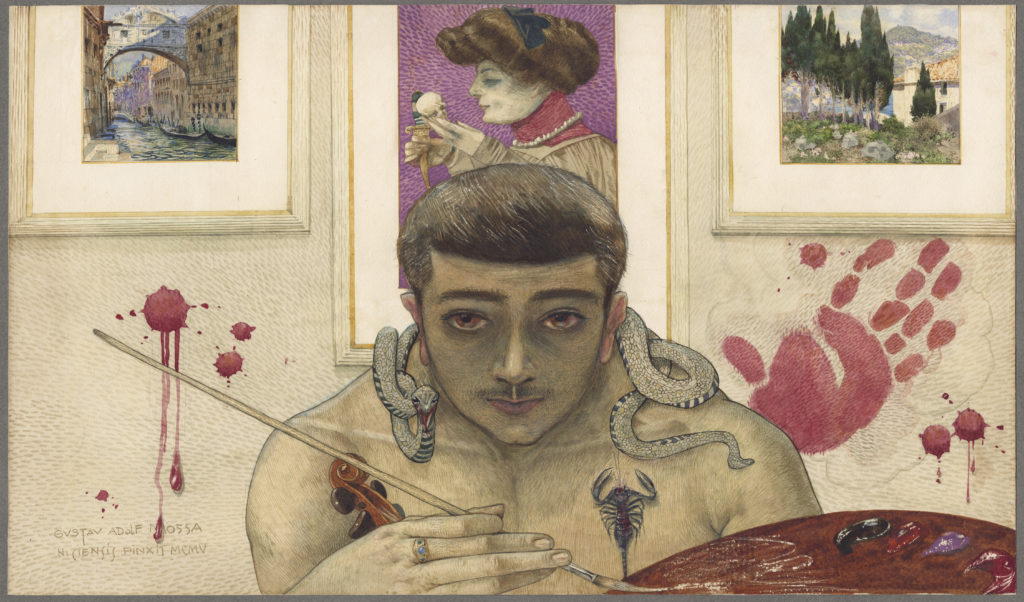Gustav-Adolf Mossa was initiated to watercolor by his father, Alexis Mossa, his only teacher and a landscape painter and professor at the Ecole nationale des Arts décoratifs in Nice. Together they travelled through Italy in 1902 and again in 1903 before coming back to Nice, where Gustav-Adolf started developing his own style, founded on a highly symbolistic and obsessive imaginary. The reason why – shortly after his return from Italy and quite without precedence – he was able to build such an outstanding, unique and creative symbolist oeuvre, remains a mystery. The secret genesis of his work inevitably aroused the interest of psychologists and psychoanalysts, but their varied interpretations were often contradictory: one stresses the smothering role of an over-possessive mother, while another refers to the aura of the paternal image, the statue of the Commander, etc. For instance, the psychiatrist Guy Darcourt has suggested that Mossa’s artistic productions illustrate fantasies that could be associated to neurosis. However, one point can be made: literature undoubtedly remains at the core of Mossa’s artistic creation. It was his sensual enjoyment and deep knowledge of a vast literary corpus that provided Mossa with his inspiration. His library, now kept at the Palais Masséna in Nice, shows his very great interest in poets, tragic epics, classical music, but also for the newly established sciences of psychanalysis. Even if Mossa had no medical background and was not familiar at all with the Parisian or Viennese circles of neurologists, he had books and papers by Charcot and Freud in his library.
It is in this context that the current and captivating self-portrait appeared at the early stage of his oeuvre. The young artist has represented himself in a frontal manner, bare backed, with red eyes and retracted shoulders, suggesting the darkness of this state of mind, and with his palette and a (phallic?) brush in his hands. This feeling is further exalted through the different details and symbols composing the portrait. An aggressive snake surrounds his shoulders and a scorpion covered with blood figures on his chest. If, following symbolic tradition, the presence of the reptile has often been associated with evil, the scorpion significance is less straightforward. Mossa has probably borrowed the motif from a crucifixion painted in the 15th century, attributed to Giovanni Canavesio, in Notre-Dame-des-Fontaine at La Brigue, near Nice. In the fresco, the scorpion is visible on a yellow flag held by roman soldiers assisting the crucifixion. In the context of this drawing, the association of the scorpion to blood could be further understood through the idea of suffering, echoing the Passion of the Christ. But it is also an echo of sexual connotation and Ophidian representations, that make of this animal a divinity.
The blood spots and handprint covering the wall further underline this image of pain and despair. Represented holding an elongated brush, a palette and violin, Mossa presents himself both as a painter and a musician, underlining the complexity of his identity. In the same perspective, the background is decorated with three drawings: a venetian setting of the Bridge of Sighs, a woman menacing a hydrocephalic foetus with a knife, which could raise many further interpretations (…), and a Provencal landscape. The arrangement with the two landscapes situates Mossa in filiation with his father and evokes the two places that mattered most to him. The Ponte dei Sospiri in Venice is moreover a symbol of death in art, etc., Mossa’s symbols often being layered and abounding within his oeuvre.
As suggested in the title chosen for the catalogue raisonné, the present sheet has been understood as a psychological introspection by the artist of him-self. It is a portrait that, like the Oracle of Delphi, reveals and obscures at the same time.
It has also been
considered as the first Freudian self-portrait in the history of art. The intense
and literary discussions at the end of the 19th and early 20th
century, about the monster hidden within the human body are clearly another way
to understand this work. All these approaches are very tempting, yet the truth
remains a secret. From 1919, Mossa systematically kept hidden his own “world”
in portfolio and didn’t speak about his symbolist and allegorical creation,
even to those close to him. This silence is at the very heart of the enigma. After
his death, his bequest to the Musée des
Beaux-Arts of Nice of a collection of his works has revealed this
extraordinary corpus. Works that are being rediscovered only today, inciting
great interest and raising many questions.






